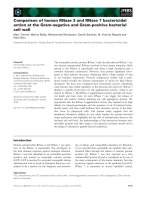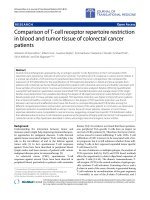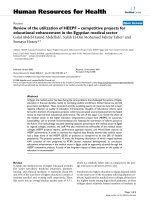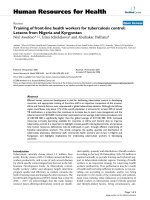Báo cáo sinh học: " Comparison of real-time PCR and hemagglutination assay for quantitation of human polyomavirus JC" pptx
Bạn đang xem bản rút gọn của tài liệu. Xem và tải ngay bản đầy đủ của tài liệu tại đây (273.73 KB, 5 trang )
BioMed Central
Page 1 of 5
(page number not for citation purposes)
Virology Journal
Open Access
Short report
Comparison of real-time PCR and hemagglutination assay for
quantitation of human polyomavirus JC
Moti L Chapagain, Taylor Nguyen, Thomas Bui, Saguna Verma and
Vivek R Nerurkar*
Address: Retrovirology Research Laboratory, Department of Tropical Medicine, Medical Microbiology and Pharmacology, Asia-Pacific Institute of
Tropical Medicine and Infectious Diseases, John A. Burns of School of Medicine, University of Hawaii, 651 Ilalo Street, BSB 325AA, Honolulu,
Hawaii 96813, USA
Email: Moti L Chapagain - ; Taylor Nguyen - ; Thomas Bui - ;
Saguna Verma - ; Vivek R Nerurkar* -
* Corresponding author
Abstract
Human polyomavirus JC (JCV), the etiological agent of the disease progressive multifocal
leukoencephalopathy (PML) affects immunocompromised patients particularly patients with AIDS.
In vitro studies of JCV infection are hampered by the lack of sensitive JCV quantitation tests.
Although the hemagglutination (HA) assay has been routinely employed for in vitro quantitation of
JCV, its sensitivity is severely limited. We have employed a real-time PCR assay which compares
favorably with the HA assay for the in vitro quantitation of JCV. JCV(Mad1), propagated in primary
human fetal glial (PHFG) cells in two independent laboratories, was purified and quantitated by the
HA assay. Both batches of purified JCV(Mad1) were then serially diluted in Dulbecco's Modified
Eagle's Medium to obtain HA titers ranging from 64 to 0.001 HA units (HAU) per 100 µL of virus
suspension. DNA was extracted from 100 µL of virus suspension and eluted in 50 µL of buffer, and
DNA amplification and quantitation were performed in the Bio-Rad iCycler iQ Multicolor Real-
Time PCR Detection System using T-antigen as the target gene. Real-time PCR for quantitation of
JCV was sensitive and consistently detected 1.8 × 10
1
copies of JCV DNA, and as low as 0.001 HAU
equivalent of JCV. Moreover, there was a strong linear correlation between the HA assay and the
DNA copy number of JCV(Mad1). The intra-run and inter-run coefficients of variation for the JCV
standard curve were 0.06% to 4.8% and 2.6% to 5.2%, respectively. Based on these data, real-time
PCR can replace the less-sensitive HA assay for the reliable detection, quantitation and monitoring
of in vitro JCV replication.
Findings
Human polyomavirus JC (JCV), a small, non-enveloped
virus with a closed circular double-stranded-DNA
genome, is ubiquitous in nature with a seroprevalence of
up to 80% among geographically isolated populations [1-
3]. JCV was first isolated in 1971 from the brain of a
patient with progressive mulifocal leukoencephalopathy
(PML) [4]. Most primary JCV infections occur during
childhood [3], and are subclinical. However, JCV remains
latent for life and may cause a fatal demyelinating disease,
PML, among immunocompromised patients [5]. PML
remains a frequent and life-threatening complication of
Published: 09 January 2006
Virology Journal 2006, 3:3 doi:10.1186/1743-422X-3-3
Received: 04 September 2005
Accepted: 09 January 2006
This article is available from: />© 2006 Chapagain et al; licensee BioMed Central Ltd.
This is an Open Access article distributed under the terms of the Creative Commons Attribution License ( />),
which permits unrestricted use, distribution, and reproduction in any medium, provided the original work is properly cited.
Virology Journal 2006, 3:3 />Page 2 of 5
(page number not for citation purposes)
HIV infection and about 3–5% of AIDS patients develop
this disease [6,7]. Factors influencing PML pathogenesis,
including modes of JCV transmission, its dissemination
from site(s) of initial infection, the mechanism(s) of JCV
reactivation, cellular susceptibility, trafficking across the
blood-brain-barrier and lytic infection of oligodendro-
cytes, are still unclear. Efforts to understand the pathogen-
esis of PML have been hampered by the lack of standard
methods for JCV detection and quantitation.
JCV major capsid protein, VP-1, is responsible for red
blood cell (RBC) agglutination and traditionally, hemag-
glutination (HA) and HA inhibition (HAI) assays have
been employed for quantitation of JCV [8-14]. However,
the HA assay is poorly sensitive and the in vitro quantita-
tion of JC viral load by HA is often impossible. Moreover
HA assay cannot be efficiently employed to study JCV rep-
lication in various experimental settings including, exper-
iments employing microtiter and transwell plates. Semi-
quantitative polymerase chain reaction (PCR) and quan-
titative real-time PCR have been recently developed and
employed for the detection and quantitation of JCV [15-
19]. In clinical specimens, real time-PCR has proven to be
an important method for monitoring JCV viral load,
[15,20] and is a reliable marker for PML prognosis [21].
However, it is unclear how changes in viral DNA levels are
correlated with the virion levels/viral load and no effort
has been made to standardize the copy-number equiva-
lent of JCV required in in vitro JCV replication-related
experiments. To further our knowledge of PML pathogen-
esis, uniformly controlled detection and quantitation
techniques are essential for in vitro monitoring of JCV rep-
lication. In this study, we investigated the relationship
between real-time PCR and HA assays for the determina-
tion of JC viral load.
JCV(Mad1) was propagated in primary human fetal glial
(PHFG) cells and purified in Dr. Duard Walker's labora-
tory (I) [4,22,23] or at the Retrovirology Research Labora-
tory (RRL) (II), University of Hawaii [13,24]. PHFG cells,
infected with JCV(Mad1) at RRL were harvested on day 30
post infection, subjected to three freeze-thaw cycles, dis-
rupted by sonication at 100 watt for 1 min on ice using an
Autotune series high-intensity ultrasonic processor, and
incubated with 0.25% deoxycholic acid at 37°C for 1 hr.
Cellular debris was removed by centrifugation at 5,000
rpm (1,960 × g) for 30 min and the supernatant was lay-
ered on 30% sucrose (w/w) and centrifuged at 35,000
rpm in a Beckman SW 55Ti rotor using a Beckman LE-80K
ultracentrifuge (Beckman Coulter, Inc., Fullerton, CA).
The supernatant was decanted and the pellet was sus-
pended in Dulbecco's Modified Eagle's Medium (DMEM)
and stored at -80°C. JCV titers were determined by the HA
assay as described elsewhere [3,10]. Briefly, human type O
blood was centrifuged at 2,500 rpm for 10 min at 4°C.
RBC were then washed twice and suspended in Alsever's
buffer (20 mM sodium citrate, 72 mM NaCl, 100 mM glu-
cose, pH 6.5 adjusted with acetic acid) at a final concen-
tration of 0.5%. Serial two-fold dilutions of virus
suspensions were prepared in Alsever's buffer and 50 µL of
viral suspension and an equal volume of RBC were added
into each well of a 96-well "U" bottom microtiter plate
and incubated at 4°C for 3–6 hr. The HA titer was the
reciprocal of the final dilution of virus suspension that
agglutinated RBC. The end point dilution was considered
1 hemagglutination unit (HAU).
Both batches of JCV(Mad1) (I and II) were serially diluted
two-fold (64 HA to 1 HA) and then 10-fold (1 HA to
0.001 HA) in DMEM, to obtain HA titers ranging from 64
HAU to 0.001 HAU per 100 µL of the suspension. DNA
was extracted from 100 µL of the above suspension con-
taining known HAU of JCV using the QIAprep
®
Spin Min-
iprep kit (Cat No. 27106), according to the
manufacturer's instructions and DNA was eluted in 50 µL
of elution buffer [25]. JCV DNA amplification and quan-
titation were performed in the Bio-Rad iCycler iQ™ Multi-
color Real-Time PCR Detection System using 2 µL of 1:10
diluted template DNA, Bio-Rad 2X iQ™ SYBER
®
Green
supermix and 12.5 pmol each of forward and reverse
primers specific for the JCV T-antigen gene [JCT-1 (For-
ward: 5' AGA GTG TTG GGA TCC TGT GTT TT 3'; JCT-2
(Reverse) 5' GAG AAG TGG GAT GAA GAC CTG TTT 3']
(GeneBank Accession No. J02226) [15] in a final reaction
volume of 20 µL. Thermal cycling was initiated with a first
denaturation step of 10 min at 95°C, followed by 40
cycles of 95°C for 10 sec and 60°C for 15 sec and the
amplification fluorescence was read at 60°C at the end of
the cycle. Real-time PCR amplification data were analyzed
using the Bio-Rad iCycler iQ™ Multicolor Real-Time PCR
Optical System Software Version 3.1. A standard curve for
the quantitation of JCV was constructed using serial dilu-
tions of the linearized JCV(Mad1) plasmid. The dynamic
range of detection was determined by preparing 10-fold
serial dilutions of JCV plasmid in the range of 10 pg to 1
fg, that represented 1.8 × 10
5
to 1.8 × 10
1
copies of JCV
DNA, respectively. All experiments were done twice and
samples were run in triplicate each time. Copies of JCV
DNA in experimental samples were calculated from the
standard curve and were expressed as copies of viral DNA
per 100 µL of virus suspension. The reliability of real-time
PCR was defined by calculating coefficients of variation of
Ct values of replicates of standard curve dilutions [21,26].
We first examined the fidelity of real-time quantitative
PCR in detecting and quantitating JCV T-antigen gene
sequences from clinical specimens. Quantitative real-time
PCR proved to be an appropriate technique for detection
of JCV DNA. The JCV T-antigen gene standard curve was
highly reproducible and precise (Fig 1B). The intra-run
Virology Journal 2006, 3:3 />Page 3 of 5
(page number not for citation purposes)
A – C: Analysis of HA and quantitative real-time PCR data employed for the determination of JC viral loadFigure 1
A – C: Analysis of HA and quantitative real-time PCR data employed for the determination of JC viral load.
JCV (Mad1), propagated in Dr. Walker's laboratory (I) or propagated at the RRL (II) was serially diluted with DMEM to make
100 µl of viral suspension containing 64 HAU to 0.001 HAU of JCV. DNA was extracted using a QIAprep Miniprep Spin Kit
and eluted in 50 µl of the elution buffer. Two µl of the 1:10 diluted template DNA was used for PCR in a final volume of 20 µl
of PCR mixture. Copies of JCV(Mad1) T antigen gene were calculated from the standard curve and were expressed as copies
of viral DNA per 100 µl of suspension. A) Amplification plots of relative fluorescence units (RFU) vs. cycle number of the JCV
T antigen gene in known amounts of JCV plasmid DNA, ranging from 10 pg to 1 fg in decreasing 1:10 serial dilutions. B) Stand-
ard curve plot of the log of plasmid copy number against cycle threshold (Ct), where Ct is defined as the first cycle in which
amplification signal is detected over mean baseline signal. The slope was -3.32 and r
2
= 1.00. C) The data representative of two
independent experiments with samples tested in triplicate for each run of real-time PCR. Standard error bars are represented
as standard deviation. The slopes were Y = 3 × 10
6
X - 350714 and Y = 4 × 10
6
X + 1 × 10
7
and the r
2
were 1.0 and 0.95 for
JCV(Mad1) virus stocks I and II, respectively.
3000
2500
2000
1500
1000
500
0
-500
PCR baseline subtracted CF RFU
0 2 4 6 8 1012141618202224262830323436384042
Cycle number
4x10
8
3x10
8
2x10
8
1x10
8
1x10
4
010203040 50 6070
HA units
JCV T-antigen gene copy number
123456
Starting Copy Number (Log)
34
30
26
22
18
Threshold cycle (Ct)
B
C
Co-relation Coefficient 1.0, Slope: -3.423, Intercept: 33.503 Y=3.423X + 33.503
PCR efficiency 96.0%,
I
II
1
0
p
g
1
p
g
1
0
0
fg
1
0
fg
1
fg
A
Virology Journal 2006, 3:3 />Page 4 of 5
(page number not for citation purposes)
and inter-run coefficients of variation for the standard
curve varied from 0.06% to 4.8% and 2.6% to 5.2%,
respectively, and thus appeared to be consistent for detect-
ing and quantitating the JCV genome copy numbers.
Moreover, re-extraction of DNA from 100 µL of JCV sus-
pension, with known HAU, yielded less than a two-fold
variation in JCV DNA copy numbers. Our JCV assay dem-
onstrated a wide linear range and was able to detect as low
as 1.8 × 10
1
copies of JCV DNA present in the template
(Fig 1A) and 0.001 HAU equivalent of JCV in 100 µL of
the virus suspension (data not shown). Thus real-time
PCR was at least 1,000-fold more sensitive than the tradi-
tional HA assay in detecting JCV.
There was a strong linear correlation between the HA
assay and the DNA copy number of JCV(Mad1) either
propagated by Dr. Walker (I, r
2
= 1.0) or propagated at the
RRL (II, r
2
= 0.95) (Fig 1C). JCV(Mad1) obtained from two
different sources yielded very similar DNA T-antigen gene
copy numbers from samples containing the same HAU of
JCV. However, the difference was more pronounced when
the suspension contained less than 4 HAU of JCV. This
difference might have resulted from the presence of differ-
ent proportions of either the empty virions or naked DNA.
The ratio of empty virions and naked JCV DNA present in
virus suspension may be affected by several factors includ-
ing the virus strain, cell type used to propagate JCV, virus
isolation procedures as well as time of harvesting the
infected cells. Moreover, the less than two-fold difference
in JCV copy numbers in two sources of virus may simply
be the result of the less sensitive HA assay. The HA assay
produced similar results when the virions in any two sam-
ples differed by less than two-fold.
Our data demonstrate that real-time PCR is a sensitive and
reliable method for in vitro quantitation of JCV. In vitro
measurement of JCV DNA levels was highly reproducible
over a large dynamic range, and real-time PCR was more
reliable than the HA assay for in vitro calculation of initial
virus inoculum and replicated virus. In the future, quanti-
tative real-time PCR can be employed to study in vitro effi-
cacy of several potential therapeutic agents against JCV as
well as to quantitate JCV trafficking across the blood-
brain-barrier using an in vitro model. Real-time PCR
detects as low as 0.001 HAU equivalent of JCV, eliminates
the variability traditionally associated with the HA assay,
and thus could reliably replace the HA assay employed for
JCV replication in in-vitro pathogenesis studies.
Competing interests
The author(s) declare that they have no competing inter-
ests.
Authors' contributions
Design and conception of study (VRN, MLC); develop-
ment of quantitative real-time PCR method (SV, TN);
virus culture (TB, MLC); virus purification, DNA extrac-
tion, HA assay (MLC, VRN); manuscript preparation
(MLC, VRN,). All authors read and approved the final
manuscript.
Acknowledgements
We thank Dr. Richard Frisque for the generous gift of JCV(Mad1) and Dr.
Eugene Major for his kind gift of positive controls to conduct the JCV HA
assay. We thank Dr. Richard Frisque and Dr. Richard Yanagihara, for
reviewing the manuscript, and for critical discussions throughout this study.
This study was supported by grants from the National Institute of Neuro-
logical Disorders and Stroke (S11 NS041833 and U54 039406), and from
the National Center for Research Resources (G12 RR003061 and P20
RR018727), National Institutes of Health.
References
1. Rollison DE, Helzlsouer KJ, Alberg AJ, Hoffman S, Hou J, Daniel R,
Shah KV, Major EO: Serum antibodies to JC virus, BK virus,
simian virus 40, and the risk of incident adult astrocytic brain
tumors. Cancer Epidemiol Biomarkers Prev 2003, 12:460-463.
2. Kim HS, Henson JW, Frisque RJ: Transcription and replication in
the human polyomaviruses. In Human Polyomaviruses Edited by:
Khalili K and Stoner GL. New York, Wiley-Liss, Inc.; 2001:73-126.
3. Padgett BL, Walker DL: Prevalence of antibodies in human sera
against JC virus, an isolate from a case of progressive multi-
focal leukoencephalopathy. J Infect Dis 1973, 127:467-470.
4. Padgett BL, Walker DL, ZuRhein GM, Eckroade RJ, Dessel BH: Cul-
tivation of papova-like virus from human brain with progres-
sive multifocal leucoencephalopathy. Lancet 1971, 1:1257-1260.
5. Padgett BL, Walker DL, ZuRhein GM, Hodach AE, Chou SM: JC
Papovavirus in progressive multifocal leukoencephalopathy.
J Infect Dis 1976, 133:686-690.
6. Koralnik IJ: New insights into progressive multifocal leukoen-
cephalopathy. Curr Opin Neurol 2004, 17:365-370.
7. Berger JR: Progressive multifocal leukoencephalopathy in
acquired immunodeficiency syndrome: explaining the high
incidence and disproportionate frequency of the illness rela-
tive to other immunosuppressive conditions. J Neurovirol 2003,
9:38-41.
8. Seth P, Diaz F, Tao-Cheng JH, Major EO: JC virus induces nonap-
optotic cell death of human central nervous system progen-
itor cell-derived astrocytes. J Virol 2004, 78:4884-4891.
9. Hara K, Sugimoto C, Kitamura T, Aoki N, Taguchi F, Yogo Y: Arche-
type JC virus efficiently replicates in COS-7 cells, simian cells
constitutively expressing simian virus 40 T antigen. J Virol
1998, 72:5335-5342.
10. Neel JV, Major EO, Awa AA, Glover T, Burgess A, Traub R, Curfman
B, Satoh C: Hypothesis: "Rogue cell"-type chromosomal dam-
age in lymphocytes is associated with infection with the JC
human polyoma virus and has implications for oncopenesis.
Proc Natl Acad Sci U S A 1996, 93:2690-2695.
11. Knowles WA, Luxton RW, Hand JF, Gardner SD, Brown DW: The
JC virus antibody response in serum and cerebrospinal fluid
in progressive multifocal leucoencephalopathy. Clin Diagn Virol
1995, 4:183-194.
12. Knowles WA, Pipkin P, Andrews N, Vyse A, Minor P, Brown DW,
Miller E: Population-based study of antibody to the human
polyomaviruses BKV and JCV and the simian polyomavirus
SV40. J Med Virol 2003, 71:115-123.
13. Akatani K, Imai M, Kimura M, Nagashima K, Ikegami N: Propagation
of JC virus in human neuroblastoma cell line IMR-32. J Med
Virol 1994, 43:13-19.
14. Hou J, Major EO: The efficacy of nucleoside analogs against JC
virus multiplication in a persistently infected human fetal
brain cell line. J Neurovirol 1998, 4:451-456.
15. Ryschkewitsch C, Jensen P, Hou J, Fahle G, Fischer S, Major EO:
Comparison of PCR-southern hybridization and quantitative
real-time PCR for the detection of JC and BK viral nucleotide
Publish with BioMed Central and every
scientist can read your work free of charge
"BioMed Central will be the most significant development for
disseminating the results of biomedical research in our lifetime."
Sir Paul Nurse, Cancer Research UK
Your research papers will be:
available free of charge to the entire biomedical community
peer reviewed and published immediately upon acceptance
cited in PubMed and archived on PubMed Central
yours — you keep the copyright
Submit your manuscript here:
/>BioMedcentral
Virology Journal 2006, 3:3 />Page 5 of 5
(page number not for citation purposes)
sequences in urine and cerebrospinal fluid. J Virol Methods 2004,
121:217-221.
16. Whiley DM, Mackay IM, Sloots TP: Detection and differentiation
of human polyomaviruses JC and BK by LightCycler PCR. J
Clin Microbiol 2001, 39:4357-4361.
17. Beck RC, Kohn DJ, Tuohy MJ, Prayson RA, Yen-Lieberman B, Procop
GW: Detection of polyoma virus in brain tissue of patients
with progressive multifocal leukoencephalopathy by real-
time PCR and pyrosequencing. Diagn Mol Pathol 2004, 13:15-21.
18. Watzinger F, Suda M, Preuner S, Baumgartinger R, Ebner K, Baskova
L, Niesters HG, Lawitschka A, Lion T: Real-time quantitative
PCR assays for detection and monitoring of pathogenic
human viruses in immunosuppressed pediatric patients. J
Clin Microbiol 2004, 42:5189-5198.
19. Verma S, Ziegler K, Ananthula P, Co JKG, Frisque RJ, Yanagihara R,
Nerurkar VR: JC virus induces altered patterns of cellular gene
expression: Interferon-inducible genes as major transcrip-
tional targets. Virology 2005.
20. Rollison DE, Utaipat U, Ryschkewitsch C, Hou J, Goldthwaite P, Dan-
iel R, Helzlsouer KJ, Burger PC, Shah KV, Major EO: Investigation
of human brain tumors for the presence of polyomavirus
genome sequences by two independent laboratories. Int J
Cancer 2005, 113:769-774.
21. Bossolasco S, Calori G, Moretti F, Boschini A, Bertelli D, Mena M,
Gerevini S, Bestetti A, Pedale R, Sala S, Lazzarin A, Cinque P: Prog-
nostic significance of JC virus DNA levels in cerebrospinal
fluid of patients with HIV-associated progressive multifocal
leukoencephalopathy. Clin Infect Dis 2005, 40:738-744.
22. Padgett BL, Rogers CM, Walker DL: JC virus, a human polyoma-
virus associated with progressive multifocal leukoencepha-
lopathy: additional biological characteristics and antigenic
relationships. Infect Immun 1977, 15:656-662.
23. Osborn JE, Robertson SM, Padgett BL, Walker DL, Weisblum B:
Comparison of JC and BK human papovaviruses with simian
virus 40: DNA homology studies. J Virol 1976, 19:675-684.
24. Liu CK, Hope AP, Atwood WJ: The human polyomavirus, JCV,
does not share receptor specificity with SV40 on human glial
cells. J Neurovirol 1998, 4:49-58.
25. Ziegler K, Bui T, Frisque RJ, Grandinetti A, Nerurkar VR: A rapid in
vitro polyomavirus DNA replication assay. J Virol Methods
2004, 122:123-127.
26. Reed GF, Lynn F, Meade BD: Use of coefficient of variation in
assessing variability of quantitative assays. Clin Diagn Lab Immu-
nol 2002, 9:1235-1239.









